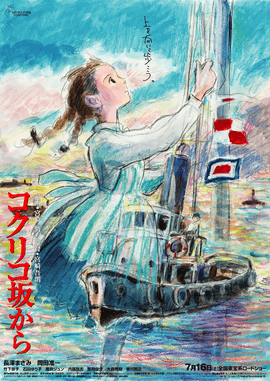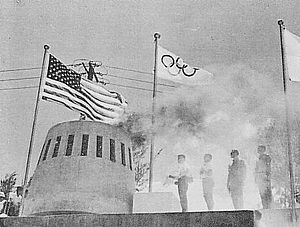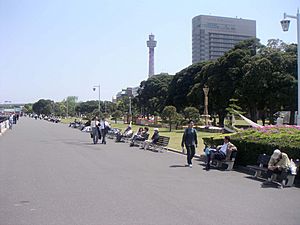From Up on Poppy Hill facts for kids
Quick facts for kids From Up on Poppy Hill |
|
|---|---|

Japanese theatrical poster by Hayao Miyazaki
|
|
| Directed by | Gorō Miyazaki |
| Produced by | Toshio Suzuki |
| Screenplay by |
|
| Starring |
|
| Music by | Satoshi Takebe |
| Cinematography | Atsushi Okui |
| Editing by | Takeshi Seyama |
| Studio | Studio Ghibli |
| Distributed by | Toho |
| Release date(s) | July 16, 2011 (Japan) |
| Running time | 92 minutes |
| Country | Japan |
| Language | Japanese |
| Budget | |
| Money made |
|
From Up on Poppy Hill (Japanese: コクリコ坂から, Hepburn: Kokuriko-zaka Kara, "From Coquelicot Hill") is a 2011 Japanese animated drama film. It was directed by Gorō Miyazaki and written by Hayao Miyazaki and Keiko Niwa. The famous Studio Ghibli made the animation.
The movie is based on a 1980 manga (Japanese comic book) called Kokuriko-zaka kara. It features the voices of Masami Nagasawa and Junichi Okada.
The story takes place in 1963 in Yokohama, Japan. It follows Umi Matsuzaki, a high school girl who lives in a boarding house called 'Coquelicot Manor'. Umi meets Shun Kazama, who is part of the school's newspaper club. They decide to clean up their school's old clubhouse, called Quartier Latin.
However, a businessman named Tokumaru wants to tear down the building. Umi, Shun, and their friend Shirō Mizunuma must try to convince him to change his mind. The film first came out in Japan on July 16, 2011. It was liked by many critics and earned over $61 million worldwide.
Story of the Film
Umi Matsuzaki is a 16-year-old high school student. She lives in Coquelicot Manor, a house that looks over the Port of Yokohama in Japan. Her mother, Ryoko, is a medical professor studying in the United States. Umi takes care of the house, her younger siblings, and her grandmother.
Every morning, Umi raises special signal flags. These flags send the message, "I pray for safe voyages."
One day, a poem about these flags appears in the school newspaper. Shun Kazama, who wrote the poem, sees Umi's flags from his father's tugboat. At first, Umi doesn't think much of Shun. He does a daring stunt to support the "Latin Quartier". This is an old building at their high school where clubs meet. It is in danger of being torn down.
Umi's sister asks her to get Shun's autograph at the Latin Quartier. There, Umi learns that Shun and Shirō Mizunuma, the student president, run the school newspaper. Umi suggests that they all work together to fix up the Latin Quartier. Many students, both boys and girls, help with the renovation. As they work, Umi and Shun start to like each other.
At Coquelicot Manor, Umi shows Shun a photo of three young navy men. One of them is her father, Yūichirō Sawamura. He died during the Korean War while on a supply ship. Shun is surprised because he has a copy of the same photo.
Shun's father then tells him that Yūichirō brought baby Shun to their house after World War II. The Kazamas had just lost their own baby, so they adopted Shun. At first, Shun avoids Umi. Then, he tells her that they might be brother and sister. Umi and Shun try to ignore their romantic feelings and stay friends.
The Latin Quartier is fully renovated. But the school board still plans to demolish the building. Shirō, Shun, and Umi travel to Tokyo. Tokyo is getting ready for the 1964 Summer Olympics. They meet Tokumaru, the chairman of the school board. They successfully convince him to visit the Latin Quartier. Later, Umi tells Shun she loves him, and he feels the same way, even with their confusing situation.
Back home, Umi's mother returns. She tells Umi that Shun's real father was Hiroshi Tachibana. He was the second man in the photo. In 1945, Tachibana died in an accident on a ship bringing people home after the war. Shun's mother died when he was born. His other family members died in the bombing of Nagasaki.
Umi's mother could not raise Shun because she was already pregnant with Umi. So, Yūichirō registered Shun as his own child. This was to make sure Shun was not left alone in the confusing time after the war. Later, Shun was given to the Kazama family.
Tokumaru visits the Latin Quartier. He is impressed by how hard the students worked. He decides not to tear down the building. Umi and Shun are called to the harbor. They meet Yoshio Onodera, who is now a ship's captain. He is the third man in the photograph and the only one still alive. He confirms that Umi and Shun are not related by blood. He tells them the full story of the three men. With everything solved, Umi continues her daily routine of raising the flags. Now, she raises them not just for her father, but for everyone.
Main Voice Actors
Here are some of the main actors who lent their voices to the characters:
- Masami Nagasawa voices Umi Matsuzaki (松崎 海, Matsuzaki Umi). She is the oldest daughter who runs the boarding house. In English, Umi is voiced by Sarah Bolger.
- Junichi Okada voices Shun Kazama (風間 俊, Kazama Shun). He is the school newspaper president. In English, Shun is voiced by Anton Yelchin. Okada also secretly voices Umi's deceased father, Yūichirō Sawamura.
- Keiko Takeshita voices Hana Matsuzaki (松崎 花, Matsuzaki Hana). She is Umi's grandmother and the owner of the boarding house.
- Jun Fubuki voices Ryoko Matsuzaki (松崎 良子, Matsuzaki Ryōko). She is Umi's mother, a medical professor.
- Yuriko Ishida voices Miki Hokuto (北斗 美樹, Hokuto Miki). She is a doctor-in-training staying at Coquelicot Manor.
- Nao Ōmori voices Akio Kazama (風間 明雄, Kazama Akio). He is Shun's adoptive father.
- Takashi Naito voices Yoshio Onodera (小野寺 善雄, Onodera Yoshio). He is a ship captain and an old friend of Umi and Shun's parents.
- Shunsuke Kazama voices Shirō Mizunuma (水沼 史郎, Mizunuma Shirō). He is the student council president and Shun's friend. Kazama also secretly voices Shun's deceased father, Hiroshi Tachibana.
- Teruyuki Kagawa voices Chief Director Tokumaru (徳丸理事長, Tokumaru Rijichō). He is the chairman of the high school.
Historical Background
The film takes place in 1963, a time when Japan was changing a lot. In the movie, Umi's father died when his supply ship sank during the Korean War. Shun's biological father died on a ship bringing people home after World War II.
After Japan lost World War II, many ships were used to bring Japanese people back home. When the Korean War started, these ships and their Japanese crews helped the US military. They carried soldiers and supplies to Korea. Japanese ships played a big part in important battles like Incheon.
It is believed that many Japanese sailors and workers died in the Korean War. Some died when their ships were sunk by mines. However, the exact number of Japanese people killed in the Korean War has never been officially shared. The US and Japanese governments have also not officially recognized the role of Japanese non-soldiers in the war.
The 1960s also saw a rise in student activism in Japan. Students often protested and stood up for what they believed in. This is shown in the film when the students work together to save their clubhouse.
Images for kids
See also
 In Spanish: La colina de las amapolas para niños
In Spanish: La colina de las amapolas para niños





